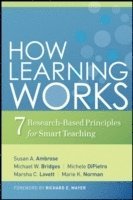
- Format
- Inbunden (Hardback)
- Språk
- Engelska
- Antal sidor
- 336
- Utgivningsdatum
- 2010-05-25
- Upplaga
- 1
- Förlag
- Jossey-Bass Inc.,U.S.
- Medarbetare
- Mayer, Richard E. (foreword)
- Illustratör/Fotograf
- Illustrations
- Illustrationer
- Drawings: 12 B&W, 0 Color; Tables: 2 B&W, 0 Color; Exhibits: 11 B&W, 0 Color
- Dimensioner
- 231 x 157 x 30 mm
- Vikt
- Antal komponenter
- 1
- Komponenter
- ,
- ISBN
- 9780470484104
- 545 g
How Learning Works
Seven Research-Based Principles for Smart Teaching
Kundrecensioner
Fler böcker av författarna
-
Woman's Guide to Navigating the Ph.D. in Engineering & Science
Barbara B Lazarus, Lisa M Ritter, Susan A Ambrose, Lazarus, Ambrose Sa
-
New Professor's Handbook
Cliff I Davidson, Susan A Ambrose, Davidson, Ambrose, Cliff I Davidson
-
Higher Education's Road to Relevance
Susan A Ambrose, Laura A Wankel, Susan A Ambrose, Laura A Wankel, Susan A Ambrose
-
Cómo funciona el aprendizaje
Susan Ambrose, Michele Dipietro, Michael W Brideges, Marshal Lovett, Marie K Norman
Övrig information
Susan A. Ambrose is Vice Provost for Teaching and Learning and Professor of Education at Northeastern University in Boston, Massachusetts. Michael W. Bridges is director of faculty development at UPMC St. Margaret Hospital in Pittsburgh, Pennsylvania. Michele DiPietro is associate director for graduate programs at the Eberly Center and instructor in the Department of Statistics at Carnegie Mellon. Marsha C. Lovett is associate director for faculty development at the Eberly Center and associate teaching professor in the Department of Psychology at Carnegie Mellon. Marie K. Norman is a teaching consultant and research associate at the Eberly Center and adjunct professor of anthropology at Carnegie Mellon. The Eberly Center for Teaching Excellence at Carnegie Mellon University was created in 1982 with a mission to distill the research on learning for faculty and graduate students and to collaborate with them to design and implement meaningful educational experiences. The center's work is based on the idea that combining the science and art of teaching empowers college faculty to create the conditions for students to learn and, through this learning, transform their world.
Innehållsförteckning
List of Figures, Tables, and Exhibits ix Foreword xiii Richard E. Mayer Acknowledgments xvii About the Authors xix Introduction Bridging Learning Research and Teaching Practice 1 1 How Does Students' Prior Knowledge Affect Their Learning? 10 2 How Does the Way Students Organize Knowledge Affect Their Learning? 40 3 What Factors Motivate Students to Learn? 66 4 How Do Students Develop Mastery? 91 5 What Kinds of Practice and Feedback Enhance Learning? 121 6 Why Do Student Development and Course Climate Matter for Student Learning? 153 7 How Do Students Become Self-Directed Learners? 188 Conclusion Applying the Seven Principles to Ourselves 217 Appendices Appendix A What is Student Self-Assessment and How Can We Use It? 225 Appendix B What are Concept Maps and How Can We Use Them? 228 Appendix C What are Rubrics and How Can We Use Them? 231 Appendix D What are Learning Objectives and How Can We Use Them? 244 Appendix E What are Ground Rules and How Can We Use Them? 248 Appendix F What are Exam Wrappers and How Can We Use Them? 251 Appendix G What are Checklists and How Can We Use Them? 255 Appendix H What is Reader Response/Peer Review and How Can We Use It? 257 References 261 Name Index 285 Subject Index 291
Du kanske gillar
-
Let Them Theory
Mel Robbins
Inbunden -
Atomic Habits
James Clear
Trade paperback (UK)
